| Article ID | Journal | Published Year | Pages | File Type |
|---|---|---|---|---|
| 3922340 | European Journal of Obstetrics & Gynecology and Reproductive Biology | 2008 | 7 Pages |
ObjectivesCervical cancer is one of the most common forms of cancer among women. Cytological screening and follow-up are potentially effective procedures for preventing the development of – and mortality from – cervical cancer. The purpose of this study was to investigate the screening history of women diagnosed with cervical cancer with the aim of improving the screening programme.Study designAll of the 187 women diagnosed with invasive cervical cancer in Malmö between 1991 and 2000 were identified, and those below 61 years of age (n = 130) were included in the analysis. The cytological and histological screening history of these women prior to their diagnosis was scrutinized. We analyzed shortcomings related to the cervical screening with special attention to participation defined as having had a cervical smear within 1 year of the scheduled time.ResultsOf the non-participants who developed cervical cancer (n = 70), roughly one-third “never participated,” half were “sub-optimal participants,” and one-sixth were “decliners,” i.e., women who declined the recommended measures. Among participants (n = 60), 80% were either “unexplained” (n = 35) or “misread as normal” (n = 13). The 9.5% subgroup of non-participants was at an 11-fold increased risk of being diagnosed with invasive cervical cancer.ConclusionThe greatest reduction in cervical cancer would be realized if non-participants could be brought into the screening program.
